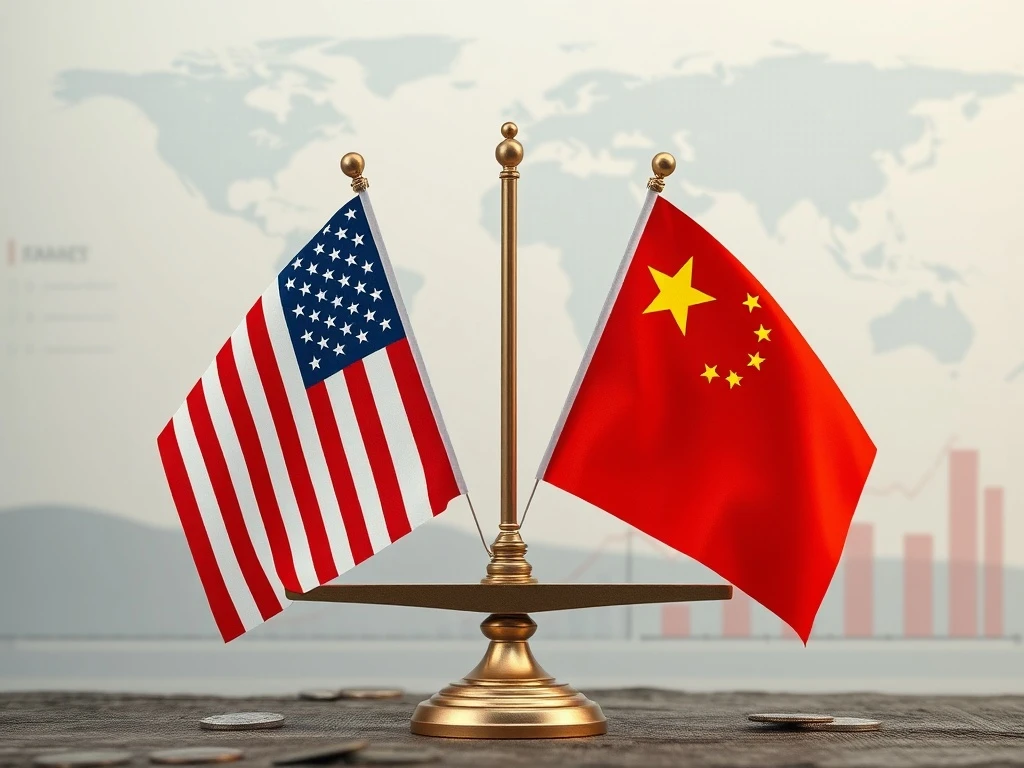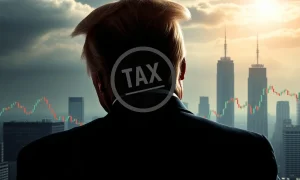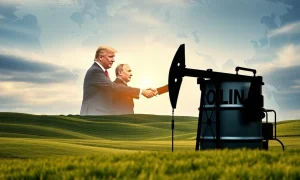The recent extension of the **US-China Trade Truce** marks a significant moment for global commerce. Business leaders and entrepreneurs closely monitor these developments. This pause in escalating tensions offers a crucial window. It provides relief for many industries. Understanding its full implications is essential for strategic planning. This article explores the nuanced effects of this truce on tariffs and the broader economic landscape.
Understanding the US-China Trade Truce
The **US-China Trade Truce** refers to a period of de-escalation in the trade dispute between the two economic superpowers. This truce typically involves a halt or reduction in new tariffs. It also often includes commitments from both sides. These commitments can cover increased purchases of goods or intellectual property protections. The primary goal is to create a more stable environment. This stability allows for continued negotiations.
Initially, the trade war began with concerns over trade imbalances. Furthermore, issues like technology transfer and intellectual property theft fueled tensions. Both nations imposed tariffs on billions of dollars worth of goods. This created significant disruption for businesses worldwide. The truce aims to mitigate these negative impacts. It seeks to prevent further economic damage.
Historical Context: The Trade War’s Genesis
The trade war between the United States and China officially began in 2018. The U.S. government cited unfair trade practices. These practices included forced technology transfers and state subsidies. China, in turn, retaliated with its own tariffs. This cycle of escalation deeply affected global supply chains. Many companies faced increased costs. Consumers also saw higher prices for various goods. The initial phase of the trade war created considerable uncertainty. Businesses delayed investment decisions. Global economic growth showed signs of slowing.
Various rounds of negotiations followed. Some attempts at resolution failed. However, a ‘Phase One’ trade deal emerged in early 2020. This agreement provided a framework for de-escalation. It included China’s commitment to buy more U.S. goods. It also addressed some intellectual property concerns. This deal laid the groundwork for the current **US-China Trade Truce**.
Immediate Impact of the US-China Trade Truce on Tariffs
The extended **US-China Trade Truce** directly impacts existing tariffs. Specifically, it means no new tariffs are immediately imposed. Furthermore, it prevents the re-escalation of previously suspended tariffs. This offers immediate relief to importers and exporters. Companies can now plan with greater certainty. They do not face the constant threat of new duties.
Consider these key points regarding tariffs:
- No New Tariffs: Both nations refrain from introducing additional duties on goods.
- Existing Tariffs Remain: Many tariffs imposed during the trade war still apply. The truce does not remove them.
- Suspended Increases: Previously threatened tariff hikes are put on hold. This prevents further cost increases.
- Negotiation Space: The truce provides time for further discussions. These talks aim to resolve underlying trade issues.
Businesses operating across borders benefit significantly. They avoid the immediate burden of new import taxes. Consequently, supply chain disruptions lessen. Companies can better manage their costs. This stability is crucial for long-term planning.
Global Market Reactions and Business Sentiment
Global financial markets typically react positively to news of a **US-China Trade Truce**. Stock markets often show an upward trend. This reflects investor optimism. Companies with significant exposure to both markets see their shares rise. Commodity prices, particularly for agricultural goods, also tend to stabilize or increase. This happens because China is a major buyer of U.S. farm products.
Business sentiment also improves. Executives feel more confident about future trade conditions. They are more likely to invest. Hiring plans may also become more robust. This positive shift in sentiment can stimulate economic activity globally. However, this optimism often remains cautious. The underlying issues in the trade relationship persist. Therefore, businesses remain watchful for any shifts.
Beyond Tariffs: Broader Economic Implications of the US-China Trade Truce
The implications of the **US-China Trade Truce** extend far beyond mere tariffs. It affects global supply chains profoundly. Many companies had begun diversifying their manufacturing bases. They sought to reduce reliance on China. This was a direct response to the trade war. The truce might slow this ‘decoupling’ process. Businesses might reconsider relocating operations. This could stabilize existing supply networks.
Moreover, the truce influences global investment flows. Investors prefer stability. A predictable trade environment encourages cross-border investments. Conversely, trade tensions deter foreign direct investment. The truce fosters an environment conducive to growth. It supports international collaboration. Furthermore, it impacts technology transfer discussions. These remain a sensitive area. The truce allows for more structured dialogue on these complex issues.
Sector-Specific Analysis
Different economic sectors experience varying impacts from the **US-China Trade Truce**. Consider the agricultural sector. U.S. farmers benefit significantly. China committed to increasing purchases of soybeans, pork, and other commodities. This provides a vital market for their produce. Conversely, technology companies face ongoing challenges. Issues like intellectual property rights and data security remain prominent. The truce offers a platform for dialogue, but deep-seated disagreements persist.
Manufacturing industries also see mixed effects. Some companies reliant on Chinese components benefit from reduced uncertainty. Others, particularly those involved in sensitive technologies, still navigate restrictions. The truce does not erase all barriers. However, it creates a less volatile operating environment. This allows companies to adapt more gradually. Therefore, careful monitoring of specific sector policies remains vital.
Challenges and Uncertainties Ahead for the US-China Trade Truce
Despite the current **US-China Trade Truce**, significant challenges persist. Fundamental disagreements between the two nations remain. These include state subsidies, industrial policies, and human rights issues. The truce is essentially a pause. It is not a comprehensive resolution. Both sides continue to jockey for technological supremacy. This competition often spills over into trade policy.
Furthermore, political shifts in either country could impact the truce. A change in leadership might lead to new trade strategies. Domestic pressures also play a role. For instance, U.S. policymakers may face calls for tougher stances on China. Similarly, China’s government responds to its own internal economic needs. These factors introduce inherent instability. Therefore, businesses must remain agile. They should prepare for potential policy shifts. This foresight helps mitigate risks.
Future Outlook for US-China Trade
The future of **US-China Trade Truce** is complex. It involves ongoing negotiations and strategic competition. Experts suggest a complete return to pre-trade war relations is unlikely. Instead, a new normal may emerge. This normal involves targeted agreements and managed competition. Both nations recognize the importance of their economic relationship. However, they also prioritize national interests. Therefore, a balance must be struck.
Future discussions will likely focus on specific sectors. Digital trade, clean energy, and advanced manufacturing are key areas. Companies should monitor these dialogues closely. They offer insights into future trade policies. Ultimately, the longevity of the truce depends on mutual political will. It also relies on the ability to find common ground. This will shape global trade for years to come.
The extended **US-China Trade Truce** offers a much-needed period of calm for the global economy. It alleviates immediate tariff pressures. It also provides a stable environment for ongoing dialogue. However, underlying tensions persist. Businesses must remain vigilant. They should adapt their strategies accordingly. The truce highlights the complex, interconnected nature of international trade. Its continued success requires sustained effort from both sides.
Frequently Asked Questions (FAQs)
Q1: What exactly does the US-China Trade Truce mean for businesses?
The **US-China Trade Truce** primarily means a pause in escalating trade tensions. Businesses benefit from no new tariffs. This allows for more predictable planning. It reduces uncertainty in supply chains. Companies can better manage costs. Existing tariffs largely remain in place, however. The truce provides a stable environment for continued negotiations.
Q2: Does the truce remove all existing tariffs between the US and China?
No, the truce does not remove all existing tariffs. Many tariffs imposed during the initial trade war remain active. The agreement prevents the imposition of new tariffs. It also halts previously threatened tariff increases. This offers significant relief. However, businesses must still account for the existing duties.
Q3: How does the US-China Trade Truce affect global supply chains?
The truce reduces pressure on companies to relocate supply chains. During the trade war, many businesses sought to diversify away from China. The truce slows this ‘decoupling’ trend. It helps stabilize existing manufacturing and distribution networks. This allows for more efficient operations. It provides greater predictability for international logistics.
Q4: What are the biggest challenges facing the US-China trade relationship despite the truce?
Significant challenges persist despite the truce. These include fundamental disagreements over intellectual property rights. State subsidies and industrial policies also remain contentious. Furthermore, human rights issues and geopolitical competition add complexity. The truce is a temporary measure. It does not resolve these deep-seated structural issues. Future negotiations will address these matters.
Q5: How might future political leadership changes impact the US-China Trade Truce?
Changes in political leadership in either the U.S. or China could significantly impact the truce. New administrations might adopt different trade policies. They could pursue more aggressive or more conciliatory approaches. This introduces a degree of uncertainty. Businesses should monitor political developments closely. They must remain prepared for potential policy shifts. This adaptability is key for navigating future trade relations.
























